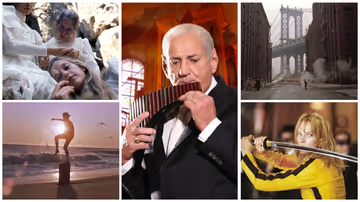In Review: 'Snow White,' 'The Alto Knights'
Disney gives its first feature film the remake treatment while two Robert De Niro's and a gang of veterans go through the motions.

Snow White
Dir. Marc Webb
109 min.
At this point, it’s probably no longer fruitful to ask why we keep getting live action (or, sometimes, “live action”) remakes of Disney classics. There’s clearly a demand for them a decade after the debut of Kenneth Branagh’s Cinderella, despite the largely undistinguished results. A few have stood out. Jon Favreau’s The Jungle Book suggested possibilities for photorealistic animated remakes,though his Lion King and Barry Jenkins’ Mufasa left those possibilities largely unrealized. Cruella offered a genuinely interesting revisionist take on a classic villain. But most have just ploddingly fleshed out the animated originals while throwing in a few dashes of spice here and there.
Snow White falls squarely in the latter category. A Marc Webb remake of Disney’s first animated feature, Snow White and the Seven Dwarfs, the film streamlines the title while padding out the fairy tale’s mythology. Via a prologue, we learn that Snow White (played as an adult by Rachel Zegler and as a child by Emilia Faucher) grew up as the princess of a happy kingdom presided over by a kindly king and queen. That happiness fades after her mother’s death and the arrival of the Evil Queen (Gal Gadot), a seductive woman from another land who bewitches then disappears Snow White’s father. But Snow White remembers the way things used to be and remains a beacon of kindness, which she exercises by freeing Jonathan (Andrew Burnap), the Robin Hood-like leader of a band of outlaws determined to resist the Evil Queen. This choice helps raise Snow White to the top of the “Fairest One of All” rankings and inspires her stepmother to order her murder.
The Reveal is a reader-supported newsletter dedicated to bringing you great essays, reviews and conversation about movies. While both free and paid subscriptions are available, please consider a paid subscription to support our long-term sustainability.
Squint and you might see a bit of commentary embedded in Snow White thanks to those additions. The Evil Queen believes in an unforgiving authoritarian system of governance that hardens the characters of her subjects. Sharing and cooperation are for the weak. She’s there to make the unnamed fantasy kingdom great again, and that has to be resisted even if taking a stand means breaking the law. But that’s deep in Snow White’s subtext. The text itself is largely concerned with the colorful production design (good), musical numbers that mix songs from the original film (good) and new originals (forgettable), and computer animated dwarfs (nightmarish).
Seemingly every aspect of Snow White has stirred up one sort of controversy or another. The concern with the depiction of dwarfs and Disney’s decision to animate Snow White’s seven friends with sharply delineated personalities is the one most relevant to the quality of the film itself. Snow White skirts the issue by treating the dwarf characters as magical beings whose frequent references to “humans” makes it clear that they’re different sorts of beings and by casting little person actors as members of Jonathan’s merry band of outlaws. Whether that’s a fair solution or not doesn’t change the fact that the dwarfs look like lawn gnomes as reimagined by Hieronymous Bosch. We see them working in a mine, but their real home is the uncanny valley.
Look past this and you’ll find a serviceable-enough reimagining of the classic film. Webb moves the action along. The dwarfs get a handful of funny lines. Zegler keeps Snow White’s sweetness but adds a layer of flintiness. Gadot plays the Evil Queen with campy abandon. It’s a performance better suited to animation than live action but, honestly, so is the rest of Snow White. —Keith Phipps
Snow White heigh-hos its way to theaters today.


The Alto Knights
Dir. Barry Levinson
123 min.
What is the point of The Alto Knights? That’s a simple question that none of the skilled (or once-skilled, more accurately) get around to answering over the course of this sleepy, by-the-numbers mob drama. It isn’t necessarily screenwriter Nicholas Pileggi’s job to figure it out. In his two collaborations with Martin Scorsese, Goodfellas and Casino, Pileggi was the source of complex mob histories and the potent anecdotes that spun out of them, but it was Scorsese who brought them style and direction, drawing out themes from the material along with his usual cinematic élan. The Alto Knights assembles a production team that seems to promise the most exciting gangster epic of 1992—Pileggi, former Scoresese producer Irwin Winkler, Bugsy director Barry Levinson, and Robert De Niro in a dual role—but the old guys do not still got it. They’ve made a film that’s about the entanglements between New York City mob bosses Frank Costello and Vito Genovese, but their reasons for doing so remain a mystery.
The existence of Scorsese’s The Irishman accounts for some of the film’s anticlimactic stupor. Scorsese and De Niro famously made several gangster pictures together, and the mournful tone of The Irishman, which deposits De Niro’s character in a space of loneliness and regret, has such a finality to it that any kind of postscript seems unnecessary. Yet here is De Niro tethered to a conceit that casts him in a dual role as separate men, neither of which he has the energy to animate. The idea seems to be to explore the ties between Frank Costello and Vito Genevese, two mob bosses who grew up friends in the same neighborhood and built a criminal empire together, only for their relationship to deteriorate to the point where Genevese ordered a hit on Costello. Perhaps they could be understood like the twin gynecologists that Jeremy Irons plays in Dead Ringers, perfectly in sync until their paths diverge radically. But The Alto Knights doesn’t achieve anything like that level of intimacy.
It opens with the break-up. In 1957 New York, Costello enters his apartment building and gets shot in the head by a Genovese henchman, who doesn’t stick around long enough to learn that the bullet slipped around the man’s skull. Costello gets bandaged up at the hospital that night and returns to the penthouse he shares with his wife Bobbie (Debra Messing), who strongly encourages him to retire. Costello has been retreating from mob life as much as possible, choosing to walk around with bodyguards or a gun, and often hobnobbing with other NYC elites at various charitable events. (The acquiescent press tends to describe him as a “professional gambler” or a “Damon Runyon type,” rather than a criminal mastermind.) Yet the attempted hit by Genovese demands a response and the film will take its sweet time getting there, first providing some context for a once-close relationship that had gone sour.
The blame falls mostly on Genovese, who De Niro plays through heavy prosthetics and heavier grievance as a relentless, near-sociopathic power player who gets what he wants through force. Through the Prohibition period and beyond, Costello and Genovese made their fortunes on vice and secured their stronghold on the city’s illicit businesses through connections to cops and politicians. De Niro’s performances makes it clear that their temperaments were always misaligned, but their mutual animus is blamed mostly on Genovese’s expansion into narcotics at a time when the government was turning its resources to stamping out the drug trade. There’s much more to it than that—credit Pileggi for sorting it all out, however exhaustingly—but suffice to say that Costello quietly crafts his own response to his friend’s betrayal.
With a title that references the neighborhood social club where the men did business, The Alto Knights attempts a muted tone that’s more like The Irishman than a bloody shoot-’em-up, but the gravitas here feels like an anchor. Pileggi’s screenplay has a ton of history to get through, which requires the voiceover of Goodfellas and Casino to burn through, but Levinson gives so little pop to the imagery that large chunks of the film are just Costello narrating over a literal slideshow. The famous sequence in Goodfellas where Henry Hill introduces various gangsters to the camera—like Jimmy Two Times, who says everything twice—is mimicked here as just a parade of indistinguishable goons. That’s The Alto Knights in a nutshell: A film that goes through the motions of a classic gangster epic while looking like an indistinguishable goon. – Scott Tobias (2/5)
The Alto Knights arrives in theaters today.





Discussion